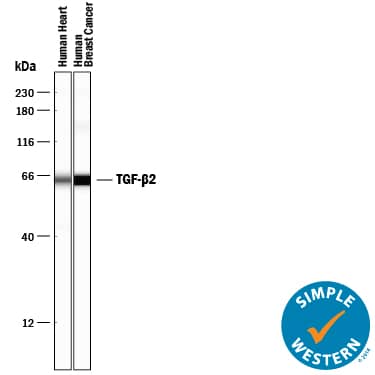TGF-beta 2 Antibody
R&D Systems, part of Bio-Techne | Catalog # AB-12-NA

Key Product Details
Species Reactivity
Validated:
Multi-Species
Cited:
Human, Porcine, Avian - Chicken
Applications
Validated:
Neutralization, Simple Western, Western Blot
Cited:
Flow Cytometry, Immunohistochemistry, Neutralization, Western Blot
Label
Unconjugated
Antibody Source
Polyclonal Rabbit IgG
Product Specifications
Immunogen
Porcine platelet-derived TGF-beta 2
Specificity
Detects TGF-beta 2 and TGF-beta 1.2 in direct ELISAs and Western blots. In direct ELISAs and Western blots, less than 2% cross-reactivity with TGF-beta 3 and TGF-beta 1 is observed.
Clonality
Polyclonal
Host
Rabbit
Isotype
IgG
Endotoxin Level
<0.10 EU per 1 μg of the antibody by the LAL method.
Scientific Data Images for TGF-beta 2 Antibody
Detection of Human TGF‑ beta2 by Western Blot.
Western blot shows lysates of human heart tissue and human breast cancer tissue. PVDF membrane was probed with 0.1 µg/mL of Rabbit Anti-TGF-beta 2 Polyclonal Antibody (Catalog # AB-12-NA) followed by HRP-conjugated Anti-Rabbit IgG Secondary Antibody (Catalog # HAF008). A specific band was detected for TGF-beta 2 at approximately 70 kDa (as indicated). This experiment was conducted under reducing conditions and using Immunoblot Buffer Group 1.Detection of Human TGF‑ beta2 by Simple WesternTM.
Simple Western lane view shows lysates of human heart tissue and human breast cancer tissue, loaded at 0.2 mg/mL. A specific band was detected for TGF‑ beta2 at approximately 64 kDa (as indicated) using 5 µg/mL of Rabbit Anti-TGF‑ beta2 Polyclonal Antibody (Catalog # AB-12-NA). This experiment was conducted under reducing conditions and using the 12-230 kDa separation system.TGF-beta 2 Inhibition of IL-4-dependent Cell Proliferation and Neutralization by TGF-beta 2 Antibody.
Porcine TGF-beta 2 (Catalog # 102-B2) inhibits Recombinant Mouse IL-4 (Catalog # 404-ML) induced proliferation in the HT-2 mouse T cell line in a dose-dependent manner (orange line). Inhibition of Recombinant Mouse IL-4 (7.5 ng/mL) activity elicited by Porcine TGF-beta 2 (1 ng/mL) is neutralized (green line) by increasing concentrations of Rabbit Anti-TGF-beta 2 Polyclonal Antibody (Catalog # AB-12-NA). The ND50 is typically 0.25-1.25 µg/mL.Applications for TGF-beta 2 Antibody
Application
Recommended Usage
Simple Western
5 µg/mL
Sample: Human heart tissue and human breast cancer tissue
Sample: Human heart tissue and human breast cancer tissue
Western Blot
0.1 µg/mL
Sample: Human heart tissue and human breast cancer tissue
Sample: Human heart tissue and human breast cancer tissue
Neutralization
Measured by its ability to neutralize TGF‑ beta2 inhibition of IL‑4-dependent proliferation in the HT‑2 mouse T cell line [Tsang, M. et al. (1995) Cytokine 7:389]. The Neutralization Dose (ND50) is typically 0.25-1.25 µg/mL in the presence of 1 ng/mL Porcine TGF‑ beta2 and 7.5 ng/mL Recombinant Mouse IL‑4.
Reviewed Applications
Read 1 review rated 3 using AB-12-NA in the following applications:
Formulation, Preparation, and Storage
Purification
Protein A or G purified
Reconstitution
Reconstitute at 1 mg/mL in sterile PBS.
Formulation
Lyophilized from a 0.2 μm filtered solution in PBS with Trehalose.
Shipping
The product is shipped at ambient temperature. Upon receipt, store it immediately at the temperature recommended below.
Stability & Storage
Use a manual defrost freezer and avoid repeated freeze-thaw cycles.
- 12 months from date of receipt, -20 to -70 °C as supplied.
- 1 month, 2 to 8 °C under sterile conditions after reconstitution.
- 6 months, -20 to -70 °C under sterile conditions after reconstitution.
Background: TGF-beta 2
References
- Sporn, M.B. (2006) Cytokine Growth Factor Rev. 17:3.
- Dunker, N. and K. Krieglstein, 2000, Eur. J. Biochem. 267:6982.
- Wahl, S.M. (2006) Immunol. Rev. 213:213.
- Chang, H. et al. (2002) Endocr. Rev. 23:787.
- Lin, J.S. et al. (2006) Reproduction 132:179.
- Hinck, A.P. et al. (1996) Biochemistry 35:8517.
- Mittl, P.R.E. et al. (1996) Protein Sci. 5:1261.
- deMartin, R. et al. (1987) EMBO J. 6:3673.
- Miyazono, K. et al. (1988) J. Biol. Chem. 263:6407.
- Oklu, R. and R. Hesketh (2000) Biochem. J. 352:601.
- de Caestecker, M. et al. (2004) Cytokine Growth Factor Rev. 15:1.
- Zuniga, J.E. et al. (2005) J. Mol. Biol. 354:1052.
Long Name
Transforming Growth Factor beta 2
Alternate Names
TGFB2, TGFbeta 2
Gene Symbol
TGFB2
Additional TGF-beta 2 Products
Product Documents for TGF-beta 2 Antibody
Product Specific Notices for TGF-beta 2 Antibody
For research use only
